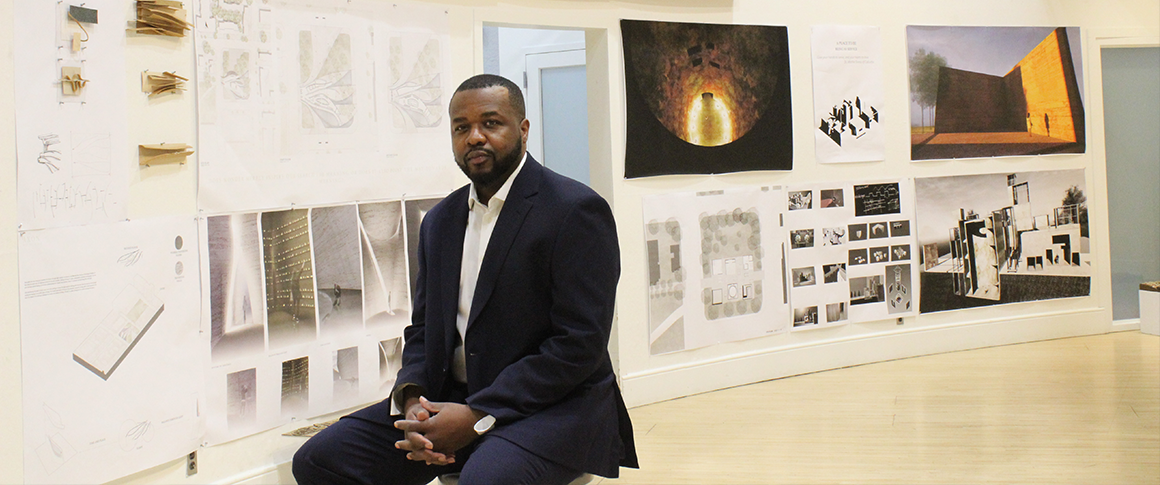Created by NCARB in 2015, the Integrated Path to Architectural Licensure (IPAL) creates an additional pathway for motivated students working toward earning a license. Incorporated as an optional path within existing National Architectural Accrediting Board (NAAB) accredited programs, IPAL allows students to complete the Architectural Experience Program® (AXP®) and the Architect Registration Examination® (ARE)® while earning a degree.

Find an IPAL Program Near You
See a list of all participating IPAL programs on our website—there could be a program near you!
Michael Matthews shares his unique experience and opportunities as an IPAL student at the Catholic University of America, plus some helpful advice for prospective students.
What inspired you to become an architect?
Ever since I was a child, I’ve had an interest in art and a good eye for creativity. Growing up in Baltimore wasn’t easy, and most of the time my family had very little money and couldn’t afford much. Despite this, my brother and I always found pleasure in building things out of materials we found in our neighborhood. We would search for wood, nails, and any materials we could use to build things like clubhouses, dog houses, pigeon coops, and just about anything. I would draw the design and then we’d both build it. I always enjoyed the idea of designing and building.
My passion for drawing stems from family members like my mom and uncle Randy—a Marine who served in the Vietnam War, and who I recently found out had a knack for art. I still remember how my mom would always doodle whenever she would talk on the phone, and I found pleasure in seeing what she would draw. After graduating high school, I decided to enlist in the Army rather than pursue a career in architecture.
How did you begin pursuing your architecture career?
During my last two and a half years in the Army, I had the opportunity to be exposed to a lot of good people and good programs, specifically at Walter Reed National Military Medical Center in Bethesda. I participated in art and writing groups facilitated by Community Building Art Works and Warrior Writers. These groups focused on the healing of veterans who have suffered trauma related to events from military service and/or deployments abroad. I also participated in networking groups organized by Sentinels of Freedom—meeting and connecting with other service members with similar experiences. It was there where I was able to gain the confidence to be active again in art and creativity, as I once enjoyed when I was a child.
In addition to participating in art and writing groups, I enrolled in classes at Montgomery College in Rockville, Maryland, to pursue an associate’s degree in carpentry—another area I was passionate about exploring. During the blueprint reading class, I remember my professor mentioning, “Architects are intelligent people, and they can figure anything out.” Hearing that lit a flame inside of me, and it was there when I knew I wanted to pursue my lifelong dream to become an architect. After telling my wife Gabriela and the rest of my family about this dream, they all encouraged me to go after it.
You were an active duty member of the Army before pursuing a bachelor’s and master’s degree in architecture. How has that background impacted your professional development?
Serving my country as a soldier in the U.S. Army was a great opportunity and rewarding experience. I’m very proud of my career with the Army and feel privileged to have met, connected, and served with so many great people.
The Army is a structured organization with core values like loyalty, duty, respect, selfless service, honor, integrity, and personal courage, which spell out the acronym “LDRSHIP.” In addition to practicing discipline and professionalism on a daily basis, we learned how to be confident team players, as well as solve complex problems under stressful and austere conditions. My experience with the Army has not only made me into a well-rounded person, but also taught me how to put the needs of others before my own, fulfill obligations, treat people with respect, and be grounded with integrity while facing any adversities.
Pursuing a career in architecture is very challenging, but my background has prepared me to successfully stay in course through any challenges I may face on the path to licensure and beyond. This background will also influence my professional growth and development as I continue working to become an architect.
What made you decide to participate in the Integrated Path to Architectural Licensure (IPAL) option offered at the Catholic University of America?
Having started a new career in architecture as a non-traditional student (slightly older than the students around me), I wanted to make a positive impact in the spaces where people work, live, move, and experience their lives, as soon as possible. The process to become a licensed architect may be difficult and challenging, but knowing I could potentially receive my license upon graduation through the IPAL option has motivated me even more to accomplish this goal of mine. It’ll still be as challenging as the traditional path, but the end reward will be fulfilling.
How do you think your involvement in the IPAL option at your school will expand your career opportunities?
I chose this career path because of my passion to express creativity and implement art and design into impactful designs. As an architecture student eager to design and build, I believe our number one goal is to become a licensed architect, as there’ll be a better chance of encountering more opportunities within the industry to make a positive impact. Being a part of the Catholic University of America (CUA)’s IPAL program has given me the opportunity to connect and build with so many people. The students and faculty I’ve worked with are all great people and I enjoy learning from them all the time.
How do you plan to balance completing your degree while earning experience and taking the exam?
I plan to complete CUA's IPAL program by dividing my experience and examination periods. First, I’ll continue working hard in my classes to keep up my GPA. Next, I’ll work at an internship from May to December 2020—earning experience toward the Architectural Experience Program® (AXP®). While I am interning, I will take two exams, and then return to classes at CUA for the spring semester. I will then find another internship to work and gain experience for eight months, when I plan to take two more exams. While in my graduate semesters, I plan to work at another internship and take my last two exams, and hopefully, end that semester graduating with my Master in Architecture.
What advice can you offer to other students interested in joining an IPAL program at their school?
They will have to prioritize their time—balancing their personal life with schoolwork—to be as successful as possible in their school’s IPAL program. They should also make use of all the resources from their IPAL advisor and NCARB, including blog articles and live webinars. While some will need to sacrifice their summer breaks and dedicate more of their time to focusing on schoolwork and internships, I believe it’ll all be worth it at the end. Having the right initiative, learning to prioritize your tasks, and working with others are key to being successful—not only with IPAL, but in the profession of architecture. Don’t be afraid to start setting goals too early, as it’ll give you direction.
What tools and resources does your IPAL advisor provide along your path to graduation and licensure?
My IPAL advisor Patricia Andrasik has done so much to position me and my classmates at CUA for success. She has been very proactive and assertive with making sure we have all the tools and resources, including those for the ARE, we need to accomplish our goals of graduating and gaining licensure. She schedules informative meetings and facilitates forums, linking us with prior IPAL students so that they can share their experience with us. She’s also assigned everyone with an IPAL student mentor to give us supplemental advice and assist in our IPAL journey. Patricia sets up workshops to assist us with building our resumes and portfolios so that we are prepared for job fairs. I can’t think of anything she hasn't done for us, and I really appreciate that.
What’s the best piece of career advice you’ve ever been given?
I think the best career advice I’ve ever gotten happened while serving with the 10th Mountain Division, 1st Brigade Combat Team, 1/87 Infantry Regiment deployed to Afghanistan. I was a newly promoted sergeant and was tasked with going to Firebase Orgun-E to assist with maintenance operations. The base was located in the Paktika Province, on the border between Pakistan and Afghanistan. Before going to Orgun-E, my platoon sergeant, Sgt. 1st Class Elston Watson, pulled me aside and said to me, “Sergeant Matthews, when you go to Orgun-E, make sure you take care of your soldiers … they will respect you more.” This was a gem of knowledge—so much so that it has stuck with me though my entire military career and now, my architecture career.
Respecting and taking care of your team, or soldiers in my case, is a critical piece in accomplishing all missions and tasks. Taking care of people goes a long way. Rather than being autocratic, I believe facilitating participation can be empowering and beneficial. Using a “take care of people first approach” enabled me to think of ways to motivate my soldiers and inspire them to accomplish mission-related tasks, which has proved to be a very effective mindset over the years.
How do you envision transferring your IPAL experience into a future workplace?
I'm sure there are seasoned architects who will have a lot of experience and time invested working in architecture. Some may even think that IPAL students are inferior because we’ll earn our licenses at a quicker pace than traditional students. However, I’ve experienced the hard work my fellow IPAL students and I have put in. Because we’ve worked hard in order to be successful in our IPAL experience, we’ve produced impressive work that’ll stay with us beyond the program. I plan to invest as much time and work as anybody else in the workplace, and not be afraid to ask questions so that I can be the best asset to my organization as possible.
As a note, Michael would like to acknowledge the following people for having inspired and helped him along his professional career: Abraham Fenote, Amanda Reinfelder, Anne Barlie, Ashy Palliparambil, Abraham Fenote, Augusto Ruiz, Bob Talbot, Carolyn N Bui-Nguyen, Deborah Jolissaint, ErinWitowski, Jessica Shipman, Joe Merritt, Heather Bernard, Lee Miller, Matilda Hall, Moria McGuire, McQuail Price, Mylene Huynh, Raye Leith, Seema Reza, Timothy Battle, Valerie Stemac, and Vainuupo Avegalio.
